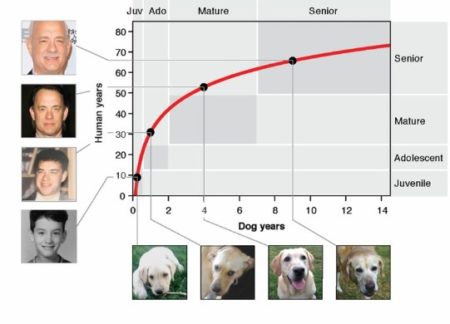November 20, 2019 – Every time I go to our dog’s veterinarian office I see a wallchart that provides age calculations for dogs looking at small and large breeds. Small breeds, the chart states, age faster in the first year and then slow down to by half in the second year, and again by half in subsequent years. So for example, our miniature red poodle, Maya, using this calculation at age 14 would be 12 (year 1) + 6 (year 2) + 36 (for the years after that) making her human age equivalence 54.
Another calculator says Maya ages 12 years in the first year and 6 in each subsequent year which would make her 90 in human years.
On Pedigree’s website, its dog age calculator goes by breed and in Maya’s case puts her age at 72 in human terms, a years older than me as of January.
It’s clear from the above that there hasn’t appeared to be an exact science on calculating the age of dogs compared to us, that is, until now.
New research studying chemical modifications to DNA over a lifetime, called epigenetics, has come up with the epigenetic clock.
What does the epigenetic clock tell us?
It tracks how sequences in our genetic makeup change from body wear and tear, lifestyle, and disease. The mechanism for the clock is DNA methylation, referring to the presence of methylcytosine found at different levels throughout the lifecycle of human DNA and that of other living things.
In a 2017 research paper entitled “DNA methylation dynamics in aging: how far are we from understanding the mechanisms?” the authors write “DNA methylation is currently the most promising molecular marker for monitoring aging and predicting life expectancy.”
Using the epigenetic clock, new research is attempting to determine a human-dog age comparison based on similar age-related methylation occurring in the two species’ genomes. Methylations can be seen in young and old dogs and humans, and the rates of change in both are similar. What might explain this is a common evolutionary trait in terms of DNA methylation going back to a common mammalian ancestry.
States Matt Kaeberlein, a biogerontologist from the University of Washington in Seattle, “We already knew that dogs get the same diseases and functional declines of aging that humans do, and this work provides evidence that similar molecular changes are also occurring during aging…a beautiful demonstration of the conserved features of the epigenetic age clocks shared by dogs and humans.”
Based on the comparison in methylation rates, a 7-week-old puppy is equal in age to a 9-month-old human baby. Then the clocks change as the one for dogs speeds up making 12 dog years equivalent to 70 for humans. DNA methylation in both species increases in aging. And it may vary in different dog breeds which has led some researchers to start the Dog Aging Project.
Getting back to Maya and figuring out an accurate age for her that isn’t based on the three methods described above, when the number 14 gets plug into the epigenetic dog clock in comes out to be 73.2 years in human terms. So the Pedigree calculator isn’t too far off. To read the original paper on dogs and epigenetic clocks, go to the link found here.















